|
|
 |
|
Calanoida ( Order ) |
|
|
|
Arietelloidea ( Superfamily ) |
|
|
|
Heterorhabdidae ( Family ) |
|
|
|
Heterostylites ( Genus ) |
|
|
| |
Heterostylites major (F. Dahl, 1894) (F,M) | |
| | | | | | | Syn.: | Heterochaeta major F. Dahl,1894;
Heterorhabdus major : Giesbrecht & Schmeil, 1898 (p.117); Wolfenden, 1905 a (p.11); van Breemen, 1908 a (p.227);
Alloiorhabdus medius Wolfenden, 1911 (p.306, figs.F); Cépède, 1914 a (p.150);
Heterochaeta zetesios Wolfenden in Fowler, 1903 (p.124, Descr.M);
Heterorhabdus longicornis Wolfenden, 1908 (p.38, Rem.M); Farran, 1908 b (p.67, Rem.);
? no Heterostylites major: Vervoort, 1951 (p.140, fig.M, Rem.);
? no Heterorhabdus nigrotinctus Brady,1918 (p.27, Rem.M, figs.M); | | | | Ref.: | | | Sars, 1925 (p.239, figs.F); Farran, 1929 (p.209, 267, Rem.); Sewell, 1932 (p.302, Rem.); Rose, 1933 a (p.208, fig.F); Jespersen, 1934 (p.108, Rem., figs.M); Hardy & Gunther, 1935 (p.182, Rem.: ?); Jespersen, 1940 (p.56, Rem.); Lysholm & al., 1945 (p.37); Sewell, 1948 (p.514, Rem.); Farran, 1948 d (n°15, p.3) Davis, 1949 (p.61: Rem.); Brodsky, 1950 (1967) (p.358, figs.F,M); Vervoort, 1957 (p.135, fig.F, Rem.); Tanaka, 1964 a (p.25, Descr.M, figs.M); Vervoort, 1965 (p.123, Rem.); Minoda, 1971 (p.40); Heptner, 1971 (p.158, Rem.F,M); Bradford, 1971 b (p.26, fig.M); Shih & al., 1971 (p.204); Björnberg & al., 1981 (p.650, figs.F); Gardner & Szabo, 1982 (p.380, figs.F, M); Razouls, 1994 (p.166, fig.F); Chihara & Murano, 1997 (p.817, Pl.117: F,M); Ohtsuka & al., 1997 (p.579, figs.F,M); Bradford-Grieve & al., 1999 (p.883, 945, figs.F,M); Bradford-Grieve,1999 b (p.89: Rem.); Park, 2000 (p.40, figs.F,M, Rem.); Vives & Shmeleva, 2007 (p.314, figs.F,M, Rem.) | 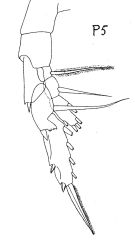 issued from : Vervoort W. in B.A.N.Z. Antarctic Research Expedition 1929-1931, 1957, B. 3. Copepods. [Fig.127]. Female (from 65°08'S, 80°58'E): left P5 (posterior aspect).
|
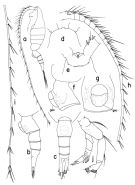 issued from : T. Park Bull. Scripps Inst. Oceanogr. Univ. California, San Diego, 2000, 31. [p.170, Fig.18].
Female: a, habitus (left side); b, c, urosome (left, dorsal, respectively); d, e, forehead (dorsal, ventral, respectively); f, g, genital somite (left, ventral, respectively); h, segments 1-16 of left A1 (ventral); i, segments 17-25 of left A1 (ventral); j, left A2 (posterior). geo = genital operculum.
Nota: Prosome length 2.68-3.41 mm.
|
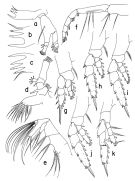 issued from : T. Park Bull. Scripps Inst. Oceanogr. Univ. California, San Diego, 2000, 31. [p.171, Fig.19].
Female: a, left Md (posterior); b, masticatory edge of left Md (posterior); c, masticatory edge of right Md (posterior); d, left Mx1 (posterior); e, left Mx2 (posterior); f, right Mxp (anterior); g, P1; h, P2; i, P3; j, P4; k, P5. P1-5 = swimming legs 1-5 (anterior)
|
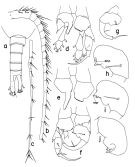 issued from : T. Park Bull. Scripps Inst. Oceanogr. Univ. California, San Diego, 2000, 31. [p.172, Fig.20].
Male: a, urosome (dorsal); b, segments 1-16 of left A1 (ventral); c, segments 17-25 of left A1 (ventral); d, P5 (with distal segments of right exopod omitted), anterior; e, basipods of P5 (anterior); f, P5 (with endopods omitted), posterior; g, exopod of right P5 (anterior); h, second exopodal segment of right P5 (posterior); i, idem (tilted counterclockwise); j, idem (anterior). dmc = distomedial corner; mpr = medial projection.
|
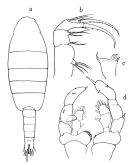 issued from : O. Tanaka in Publs Seto Mar. Biol. Lab., 1964, XII (1). [p.25, Fig.186]. Male: a, urosome (dorsal); b, Mx1; c, biting edge of Md; d, P1; e, P5; f, inner margin of 2nd segment oexopod of right P5. Nota: The urosome segments and furca are in the proportional lengths as 17:15:17:12:12:27 (left) = 100. Left A1 exceeds the end of the furca by distal 7 segments. Right A1 forms a grasping organ.
|
 Issued from : G.O. Sars in Résult. Camp. Scient. Prince Albert I, 69, pls.1-127 (1924). [Pl.LXVII, figs.17-18]. Female (from around Azores Islands & Bay of Biscay): 17, habitus (dorsal view); 18, terminal segments of A1. Nota: A1 exceeding 1/3 body length. Nota: compare the four last segments of A1 with H. longicornis ones.
|
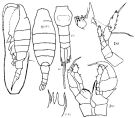 Issued from : K.A. Brodskii in Calanoida of the Far Eastern Seas and Polar Basin of the USSR. Opred. Fauna SSSR, 1950, 35 (Israel Program for Scientific Translations, Jerusalem, 1967) [p.359, Fig.252] Female (from NW Pacif.): habitus (dorsal and lateral left side); MRi, Md (biting edge, right side view): urosome (dorsal); H5, P5. Male: S5, P5.
|
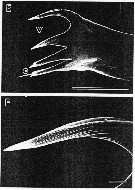 issued from : S. Ohtsuka, H.Y. Soh & S. Nishida in J. Crustacean Biol., 1997, 17 (4). [p.580, Fig.1, E, F]. Female (from S. Japan): E, right mandibular cutting edge; F, ventralmost tooth. v = ventral teeth; c = central teeth. Scale bars : 0.100 mm (E); 0.010 mm (F).
|
 issued from : S. Ohtsuka, H.Y. Soh & S. Nishida in J. Crustacean Biol., 1997, 17 (4). [p.583, Fig.4, E]. Male (S Japan): E, left side of labrum (posterior surface) with gland openings (small arrow). Scale bar: 0.010 mm.
|
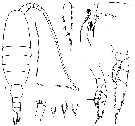 issued from : R.N. Wolfenden in Die Marinen Copepoden der Deutschen Südpolar-Expedition 1901-1903, 1911. [p.307, Fig.55]. As Alloiorhabdus medius. Female: a, habitus (dorsal); b, Mxp; c, Md (biting edge); d, P1 (distal segment of endopod); e, P2 (distal segment of endopod); f, P4 (distal segment of endopod); g, P3 (distal segment of exopod); h, P4; i, P5.
|
 Heterostylites major Heterostylites major female: 1 - Dorsally, genital somite widest at middle. 2 - Ventrally, genital operculum much wider than 1/2 width of somite (Fig.18-g). 3 - Laterally, , ventral margin of genital somite extending straight beyond posterior end of genital operculum (Fig.18-f). 4 - Laterally, 2nd urosomal somite with swollen ventral margin; setae of mouthparts conspicuously plumose.
|
 Heterostylites major Heterostylites major male: 1 - Basal lobe of right P5 relatively short (Fig.20-e); basal lobe of left P5 low and wide. 2 - In 2nd exopodal segment of right P5, medial projection with a long serrated process (Fig.20-h). 3 - Setae of mouthparts highly plumose.
| | | | | Compl. Ref.: | | | Hardy & Gunther, 1935 (1936) (p.182, Rem.: ?); Grice, 1963 a (p.496); Harding, 1974 (p.141, tab.2, gut contents); Deevey & Brooks, 1977 (p.256, tab.2, Station "S"); Buchanan & Sekerak, 1982 (p.41, vertical distribution); Chen Y.-Q., 1986 (p.205, Table 1: abundance %, Table 2: vertical distribution); Sameoyo, 1994 (p.213, Table 1); Ikeda & al., 2006 (p.1791, Table 2); Khelifi-Touhami & al., 2007 (p.327, Table 1); Schnack-Schiel & al., 2008 (p.1045: Tab.2); Gaard & al., 2008 (p.59, Table 1, N Mid-Atlantic Ridge); Galbraith, 2009 (pers. comm.); Homma & Yamaguchi, 2010 (p.965, Table 2); Homma & al., 2011 (p.29, Table 2, 3, 5, abundance); Abe & al., 2012 (p.100, temporal & vertical changes); Takenaka & al., 2012 (p.1669, fig.2, 3, Table 1, bioluminescence); Belmonte, 2018 (p.273, Table I: Italian zones) | | | | NZ: | 16 | | |
|
Distribution map of Heterostylites major by geographical zones
|
| | | | | | | | | | | | | | | 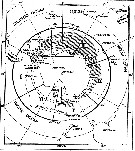 issued from : W. Vervoort in B.A.N.Z. Antarctic Reseach Expedition, Reports - Ser. B, Vol. III, 1957 [Fig.124] issued from : W. Vervoort in B.A.N.Z. Antarctic Reseach Expedition, Reports - Ser. B, Vol. III, 1957 [Fig.124]
Chart showing the geographical distribution (white triangle) in the seas surrounding the Antarctic continent.
Nota: In this chart the area frequented by whaling vessels has been hatched. The Antarctic circle (66°.5 S) has been drawn as a broken line. The numbers I to VI refer to the sectors into which the Antarctic seas are divided according to Mackintosh (1942) (after Vervoort, 1951). |
| | | | Loc: | | | Antarct. (Weddell Sea, SE Atlant., Indian, SW Pacif., Ross Sea), ? South Georgia, sub-Antarct. (Indian), South Africa, Atlant. (tropical), G. of Guinea, Cape Verde Is., off Morocco-Mauritania, Canary Is., Brazil, G. of Mexico, Florida, off Bermuda (Station "S"), Sargasso Sea, off Cape Cod, Hudson Strait, Davis Strait, W Baffin Bay, Baffin Sea, Iceland, Faroe Is., Norwegian Sea, off SW Ireland, North Sea, Ibero-moroccan Bay, W Medit. (El Kala shelf, Tyrrhenian Sea), Indian, Philippines, Japan (Izu, off Sanriku, off E Hokkaido), Station Knot, Kuril-Kamchatka, Okhotsk Sea, Bering Sea, S Aleutian Basin, S Aleutian Is., Pacif. central (sub-arct.), G. of Alaska, Icy Strait, Chile (N & S).
Type locality: Atlantic (location ?) | | | | N: | 57 | | | | Lg.: | | | (1) F: 4,7; (10) F: 5,2; (16) F: 4,1-4; M: 3,96-3,8; (22) F: 5,2-4,7; M: 5,1-4,5; (23) F: 5,75-4,9; M: 5,5-4,05; (25) F: 5,4-4,55; M: 5,09-4,14; (35) F: 4,92; M: 4,26; (44) F: 5; (49’) F: 4,8; (102) M: 4,5; (121) M: 5,38; (199) M: 4,5-4,18; (208) F: 5; M: 5; (824) F: 5-4; M: 5,16-4,12; {F: 4,00-5,75; M: 3,75-5,50} | | | | Rem.: | meso-bathypelagic. Overall Depth Range in Sargasso Sea: 500-2000 m (Deevey & Brooks, 1977, Station "S"); 2000-1000 m (Harding, 1974).
For Brodsky (1967, p.359) this species is closely related to H. longicornis; the difference lies in the size and relative length of A1 which are longer than the body by 7-9 segments against 5-6 in H. longicornis.
For Itoh (1970 a, fig.2, from co-ordonates) the Itoh's index value of the mandibular gnathobase = 2380.
This species resembles H. submajor (Cf Remark) | | | Last update : 16/11/2020 | |
|
|
 Any use of this site for a publication will be mentioned with the following reference : Any use of this site for a publication will be mentioned with the following reference :
Razouls C., Desreumaux N., Kouwenberg J. and de Bovée F., 2005-2025. - Biodiversity of Marine Planktonic Copepods (morphology, geographical distribution and biological data). Sorbonne University, CNRS. Available at http://copepodes.obs-banyuls.fr/en [Accessed August 17, 2025] © copyright 2005-2025 Sorbonne University, CNRS
|
|
 |
 |














